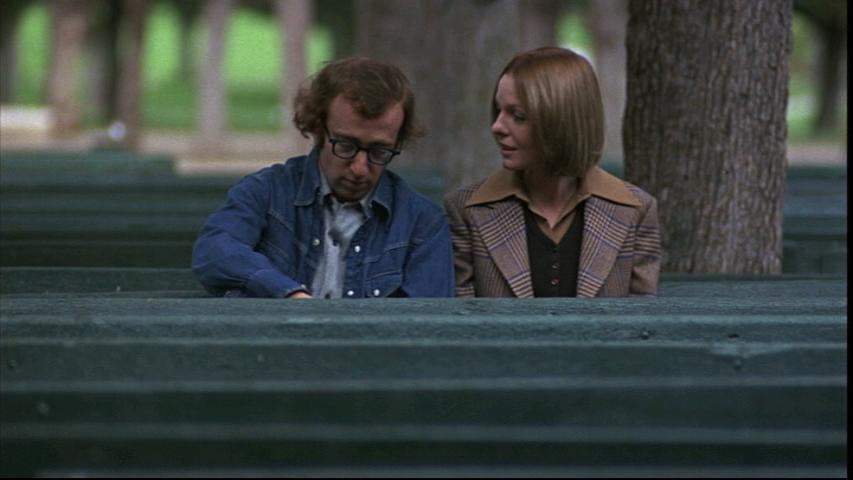← Back to Reviews
in
Play It Again Sam
Woody Allen had one of his earliest screen successes with the 1972 screen version of one of his first plays called Play it Again, Sam, which works very hard at not looking like a photographed stage play with only marginal success.

Woody plays Alan Felix, a writer who has just gone through a nasty breakup with his insensitive ex-wife (Susan Anspach). With the help of his best friends, Dick and Linda (Tony Roberts, Diana Keaton), Alan tries to forget about Nancy as Dick and Linda keep setting him up on dates trying to find the perfect woman for him, but, for Alan, the perfect woman just might be Linda.

The special hook provided for this story is that the character of Alan is a movie buff who worships everything Humphrey Bogart and throughout the story we see Alan getting advice and inspiration from the spirit of Bogey (Jerry Lacy) on the art of romance.

The play premiered in 1969 featuring Allen, Keaton, Roberts, and Lacy and ran for over 400 performances. The play takes place completely in Alan's apartment , but director Herbert Ross does his best to open the story up by having the story become bi-coastal between New York and San Francisco, but there's something about the story that still feels kind of cramped and claustrophobic.

Moviegoers' first exposure to the enigmatic screen chemistry that Woody Allen and Diane create does make this film worth investing in. As my reviews of a lot of Allen's later work reveals, I have often been put off with Woody's view of himself as a sex symbol, but I never got that narcissistic Allen that inhabits a lot of his later work here. I believed Alan's neuroses, effectively fueled by ex-wife Nancy in the early scenes and his disastrous attempts at dating that lead Alan to the reveal that he is really in love with his best friend's wife. I also wouldn't have minded a little more focus on Alan's relationship with Bogey's spirit. It's set up as such an important part of Alan's character makeup, evidenced by the overlong clip of Casablanca, I expected Bogey's spirit to have a more prominent role in the story than he did.

Ross' direction is a little wooden but he does manage charming performances out of Allen, Keaton, Ross, Lacy, and Anspach and there is some lovely location photography of Manhattan and San Francisco, but I couldn't help thinking throughout how different and possibly better this film might have been with Woody in the director's chair.
Woody Allen had one of his earliest screen successes with the 1972 screen version of one of his first plays called Play it Again, Sam, which works very hard at not looking like a photographed stage play with only marginal success.

Woody plays Alan Felix, a writer who has just gone through a nasty breakup with his insensitive ex-wife (Susan Anspach). With the help of his best friends, Dick and Linda (Tony Roberts, Diana Keaton), Alan tries to forget about Nancy as Dick and Linda keep setting him up on dates trying to find the perfect woman for him, but, for Alan, the perfect woman just might be Linda.

The special hook provided for this story is that the character of Alan is a movie buff who worships everything Humphrey Bogart and throughout the story we see Alan getting advice and inspiration from the spirit of Bogey (Jerry Lacy) on the art of romance.
The play premiered in 1969 featuring Allen, Keaton, Roberts, and Lacy and ran for over 400 performances. The play takes place completely in Alan's apartment , but director Herbert Ross does his best to open the story up by having the story become bi-coastal between New York and San Francisco, but there's something about the story that still feels kind of cramped and claustrophobic.

Moviegoers' first exposure to the enigmatic screen chemistry that Woody Allen and Diane create does make this film worth investing in. As my reviews of a lot of Allen's later work reveals, I have often been put off with Woody's view of himself as a sex symbol, but I never got that narcissistic Allen that inhabits a lot of his later work here. I believed Alan's neuroses, effectively fueled by ex-wife Nancy in the early scenes and his disastrous attempts at dating that lead Alan to the reveal that he is really in love with his best friend's wife. I also wouldn't have minded a little more focus on Alan's relationship with Bogey's spirit. It's set up as such an important part of Alan's character makeup, evidenced by the overlong clip of Casablanca, I expected Bogey's spirit to have a more prominent role in the story than he did.

Ross' direction is a little wooden but he does manage charming performances out of Allen, Keaton, Ross, Lacy, and Anspach and there is some lovely location photography of Manhattan and San Francisco, but I couldn't help thinking throughout how different and possibly better this film might have been with Woody in the director's chair.
